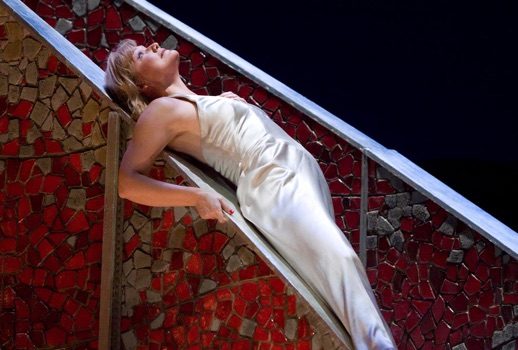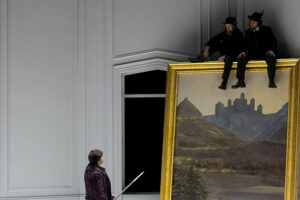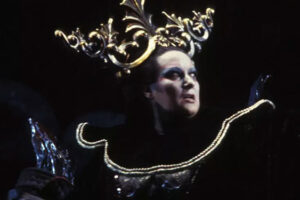

“All art is at once surface and symbol.” — Oscar Wilde
1. In 1964, at the conclusion of her famous essay “Against Interpretation,” Susan Sontag boldly claimed: “In place of a hermeneutics we need an erotics of art.” Over fifty years later the thesis remains thrilling. However, despite its terse, rhetorical force, I struggle to articulate the notion of an erotics of art. What is it exactly? Making love to the surface of things? A swoon? Capitulation to beauty?
2. Instantaneous, intractable. I gaze at the objet d’art—boing! Cupid lodges his arrow in my heart.
3. The figure of Oscar Wilde looms large in Sontag’s essay. The epigraph for “Against Interpretation” comes from Wilde: “It is only shallow people who do not judge by appearances. The mystery of the world is the visible, not the invisible.” And Sontag dedicated another essay, “Notes on Camp,” to the master. I hear the call too—the cult of surface, the cult of symbol. Those of us that sigh before the shimmering canvas. Ah! Wonder! To be struck dumb!
4. One, in fact, desires to be silenced. Speechless.
5. Here, on the surface, is the “mystery of the world.” Praise this mystery! The arrow! The bleeding heart! A frisson… Look! Everything is different; nothing will be the same. The surface is so much more reliable than the murky interior. Things that gleam and glow seduce me.
6. My favorite opera is Strauss’ Salome: a musical setting of Wilde’s one act play, in German translation by Hedwig Lachmann (grandmother of film director Mike Nichols). The opera is the closest thing I can think of to an erotics of art. No other operatic text is more preoccupied with surfaces—jewels, fabrics, food, celestial bodies, and earthbound, human bodies. The opera begins with an act of looking: “Wie schön is die Prinzessin Salome heute Nacht!”
While Salome is the initial focus of the spectator’s gaze, through her own subjective lens the opera’s primary surface becomes that of Jochanaan: the baptizer, the prophet, the one who prepares the way; he crystalizes beneath Salome’s obsessive, recursive looking. At first, he is pushed off-stage, rendered invisible (obscene?)—hidden from view in a deep, tomb-like cistern. But over the course of the opera, he becomes, through Salome’s laser-like vision, an objet d’art. As is the case in Wilde’s source material, a voluminous amount of discursive work centers on the prophet: what he looks like, what he tastes like.
7. While one might argue that it’s Jochanaan’s rebuke of Salome that sends the princess into her revenge spiral, I believe it’s more so the beauty of the man that provokes her frenzy and necrophilia. She is undone by her overwhelming desire to possess him. Her description of Jochanaan takes the form, via metaphor’s legerdemain, of a catalogue—things, textures, and surfaces. For example, upon meeting the prophet, Salome deploys simile to describe Jochanaan’s body as such:
SALOME: Seine Augen sind von allem das Schrecklichste. Sie sind wie die schwarzen Höhlen, wo die Drachen hausen! Sie sind wie schwarze Seen, aus denen irres Mondlicht flakkert…Wie abgezehrt er ist! Er ist wie ein Bildniss aus Elfenbein. Gewiss ist er keusch wie der Mond. Sein Fleisch muss sehr kühl sein, kühl wie Elfenbein. Ich möchte ihn näher beseh’n…Ich muss ihn näher beseh’n…
[It’s his eyes above all that are terrible. They are like the black caverns, where the dragons make their lair! They are like black lakes from which fantastic moons are rising…How wasted he is! He’s like a thin statue of ivory. I’m sure he is chaste like the moon. His flesh must be cool, cool like ivory. I would look closer at him…I must look closer at him…]
And later, her tactile wonder evokes overtones of sensual touch and smell, deepening and complicating her vision. Most sensually:
SALOME: Jochanaan! Ich bin verliebt in deinen Leib, Jochanaan! Dein Leib ist Weiss wie die Lilien auf einem Felde von der Sichel nie berührt. Dein Leib ist Weiss wie der Schnee auf den Bergen Judäas. Die Rosen im Garten von Arabiens Königin sind nicht so Weiss wie dein Leib, nicht die Rosen im Garten der Königin, nicht die Füsse der Dämmerung auf den Blättern, nicht die Brüste des Mondes auf dem Meere, Nichts in der Welt ist so Weiss wie dein Leib. Lass mich ihn berühren deinen Leib.
[Jochanaan, I am amorous of the body! Jochanaan! Thy body is white, like the lilies of a wide field that the mower never hath mowed. You look as white as the snows on the hills of Judea. The roses in the gardens of the queen of Arabia are not so white as thy body. Neither roses in the gardens of Arabia’s Queen, nor the feet of the dawn when they light on the flower nor the breast of the moon on the breast of the ocean: Nothing in this world is so white as thy body. Ah, let thy white body be touched by me.]
Salome is enthralled by Jochanaan’s outer form; she is less concerned with what he has to say, his prophecy against her mother Herodias. She fastens herself to his surface. Generally, this lovemaking takes the form of language and metaphor.
8. There is a Sadistic allusion within her tautology, a recursive pleasure in overwriting: rhythmic, pulsing, prodding interrogation of the skin, the hair, the lips, the eyes. She makes claims; she revises them; she discards old metaphors for new ones—an unending search to define Jochanaan’s body. She claims his body; she rejects his body; she claims his hair—black grapes, cedars, and forests—she rejects his hair; she claims his mouth—red as a scarlet band, a rose, a pomegranate, coral, vermillion buried in the ground, the trumpets of kings! Ich will deinen Mund küssen!
But through the act of definition Salome discovers a slippery, elusive aspect of language: it both enables new modes of perception, while simultaneously limiting that perception. Poor Salome. Nestled in the word define is the word finite. To define Jochanaan’s body is to render it finite. But for Salome, her desire to possess and keep Jochanaan’s body engenders an infinite naming practice.
9. Snatch! Poor Salome—caught in the Venus Fly Trap of language. Always approaching, never arriving.
10. Salome’s language fails her. Nothing fulfills her fugitive hunger. Possession is not enough. Naming is not enough. In Fragments d’un discours amoureux, Roland Barthes asks:
But isn’t desire always the same, whether the object is present or absent? Isn’t the object always absent? –This isn’t the same languor: there are two words: Pothos, desire for the absent being, and Himéros, the more burning desire for the present being.
Salome cannot find a way to hold Jochanaan. He eludes her, despite his enclosure in the cistern. And Salome’s desire in the presence of the present body turns decadent, turns toxic, turns deadly. She is rendered feverish by Himéros. She curdles into delirium. Her longing to possess destroys. She is offered all the gleaming surfaces possible, but only one surface eludes her: the thing. Jochanaan. White skin—the perfumed field of tactile temptation. She wants to possess, to touch, to taste, to swallow.
11. The verbs look and touch connote desperation and lack throughout the opera. Salome is an object of scrutiny just as much as Jochanaan. She is looked at by the Tetrarch: “Warum sieht mich der Tetrarch fortwährend so an mit seinen Maulwurfsaugen unter den zuckenden Lidern?” Herod wants her, much to her disgust. Her dance of the seven veils is a dramatic juncture, a threshold from which the characters cannot retreat. The princess strips away succeeding articles of clothing. She reveals more and more, only to finally reveal her heart of darkness—nothing but blind, sadistic hunger—like a shark. She exposes her entire body. Her performance for the Tetrarch is the height of objectification. She objectifies herself—methodology for objectifying the prophet: she reduces his body to the state of an object. In fact, it might be argued that Salome hinges on a reversal of power dynamics: that which is looked at, finally looks back—with tragic ramifications. “Gib mir den kopf des Jochanaan!”
12. Herod tries to appease Salome’s lust (bloodlust?) with poor substitutes. Other surfaces. Other things. An emerald, white peacocks, jewels: a collar of pearls, topazes—yellow, pink, and green, opals, chrysolites and beryl, chryosprases and rubies, sardonyx and hyacinth stones, stones of chalcedony, marvelous crystals (“into which to look ‘tis not lawful for women…”), and turquoises…
And finally, in an act of high blasphemy, Herod offers her the mantle of the high priest and the veil of the sanctuary. He will give her anything, “save the life of one man.” And yet she is insistent: “Gib mir den kopf des Jochanaan!”
13. And yet, when she receives her gleaming prize, something is missing—flown away on Herod’s black wings. Salome’s obsession with the objectified body finds its climax in the final scene—a demanding, twisted tableau, a tour de force for the singing actress. She clutches the bloody head of Jochanaan. She kisses it; she fucks the surface—the man is gone. All that is left is his form.
Wilde’s priority of aesthetics (over moral content?) finds its literal embodiment in that final scene. What is the difference between the body and the object? The art and the subject? Where there once was a man, there is now only a head. Where there were once vibrating sounds, words, there is only a mouth. Style without substance. The scene is rife with sensory investment: the viscous blood from Jochanaan’s neck, his hair, her dress, her hair, her lips softly pressed against his waxy mouth—Ich habe deinen mund geküsst Jochanaan! She is victorious. All surface! Nothing but surface!
14.The final scene swoons to a crescendo, despite its moral ambivalence. In light of Salome’s startling demise, would one call her final death a tragedy? Wilde did. But with Strauss’ genius intervention it’s harder to determine. Herod’s command—“Man tote dieses Weib!”—comes so quickly, that it’s affect has little time to alter the emotional tenor of the scene. I am caught off guard. Until then, there is something so triumphant in Salome’s final seizure of Jochanaan’s mouth, her victory claim: “Ich habe deinen mund geküsst Jochanaan!”
Goal accomplished. Although, triumph is, perhaps, a totally inept term for the context. Salome discovers the bitter flavors latent in the bittersweetness of love. She muses:
SALOME: Ah! Ich habe ihn geküsst, deinem Mund, es war ein bitterer Geschmack auf deinen Lippen. Hat es nach Blut geschmeckt? Nein! Doch es scmeckte vielleicht nach Liebe…Sie sagen, dass die Liebe bitter schmecke…Allein was tut’s? Was tut’s?
[SALOME: Ah! I have kissed thy mouth, there was a bitter, bitter taste on thy red lips. Was it the taste of blood? Nay! But perchance this is the taste of love…They say that love has a bitter taste…But what of that? What of that?]
Blood pools around love’s wounds. The limited, bittersweet resistance of surface is a basic element within the ontology of Eros. Eros cannot exist without the limitations of surface.
15. Salome’s blistering beauty is difficult to stomach ethically—one can hardly imagine what early audiences thought of such a spectacle of moral depravity: incest (with shades of pedophilia), murder, necrophilia. They must have been speechless. Sontag also writes in “Against Interpretation” that the act of interpretation is, in fact, a form of interjection and revision. “The interpreter,” she claims, “without erasing or rewriting a text, is altering it.”
It would be nice to interpret away the unseemliness of Salome’s desire—to recast her into a proto-feminist, or a victim, instead of letting her be the monster she is. It would be nice to ascribe a political reading to her demands, to her demise, instead of relinquishing the princess to her own agency and fate: to dance, to kill, and to die all for the sake of beauty.
https://
This is not to say that the opera doesn’t have political dimensions. But I think it would be a waste of time to try to assign a political objective to Wilde and Strauss’ rhetoric. Salome is not a feminist anti-hero. She does not ask for the head of Jochanaan to avenge her mother. She asks for it out of her own longing. Politics is not what galvanizes her; Jochanaan’s beauty is her impetus.
To assign her a political function is to reduce the complexity of her desire, the terror of her narrative. It diminishes the power of beauty. My personal guess is that Wilde would’ve detested such interpretations. Art may have political ramifications—perhaps reverberations is the better word—but it should never be overtly political. Beauty is the priority. As Wilde wrote in the preface to The Picture of Dorian Gray: “The artist is the creator of beautiful things…All art is quite useless.” The artist is not political; she deploys craft. She makes something.
https://
16. It’s for this reason that I find any effort to psychologize Salome a useless endeavor. What is frightening is her impenetrability, her imperceptible slippage from sexpot to monster. Is it so much that Salome has changed, over the course of the evening, or is it that we have changed? Viewing her by the light of different circumstances than when the opera began.
17. Concerning performances, my favorite recording of Salome is Hildegard Behrens, conducted by Karajan. Normally, I’m not a fan of Behrens—I especially dislike her Brünnhilde in Otto Schenk’s production of Der Ring des Nibelungen—but I find her performance on this recording ideal. Her piercing soprano manages to be equally deranged and girlish, highlighting the character’s unhinged naiveté. Regarding live performances, nothing I’ve seen, so far, has matched Karita Mattila in the 2000s. I unfortunately missed her house debut in the role. But I saw her a few years later, her voice reportedly more ragged than her initial outing, but still powerful and committed.
https://
On YouTube, I’ve often turned to Leonie Rysanek for her delicious insanity. And Catherine Malfitano brings terrifying dramatic commitment and voluptuous carnality. Her dance of the seven veils is astonishing for its rigor and bravery.
18. Strauss’ score is an exercise in responsibility. Chromatic, romantic, polytonal, terrifyingly aggressive—it takes full responsibility for its choices. Unlike the cult of dodecaphony that would take hold of the 20th Century musical imagination, Salome has no tone-row to blame for it’s beautiful obscenity. Nor does it cast its lot with the aleatoric experiments that John Cage, Pierre Boulez, and Karlheinz Stockhausen would later come to champion.
https://?t=4946
Strauss does not eschew his own responsibility to the material. He claims Salome’s subjectivity as a work of the auteur, a work of the imagination. This is not to say the score doesn’t make use of form (what art does not have, on some level, a formal component?)—there are obvious leitmotifs and embedded triadic structures. But the form is determined through the composer’s discernment. And choice invokes consequences. Choice acknowledges agency. Strauss chooses the form that best suits his subject material.
19. The difference between form and content is difficult to parse, the closer one looks—especially when it comes to Salome. It’s almost as if form becomes the content, and style is substance. And maybe there are broader arguments to be made here about the nature of interpretation, especially regarding the performing artist? Heraclitus certainly made a good point when he claimed that “No man every steps in the same river twice, for it’s not the same river and he’s not the same man.” Each time the singer, the conductor, the director, and the audience bring their bodies to Salome, they are never the same again. But these are things that change, they are alive and dynamic—the river, the man, the artist.
20. Salome, to a certain extent, is fixed—perfected, finished, and consummate.
Photo: Marty Sohl























Comments